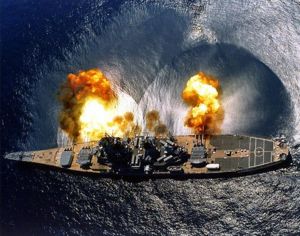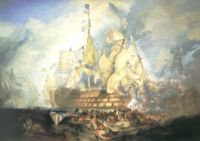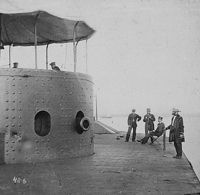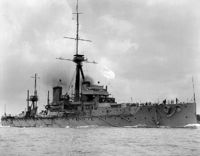Battleship
 From Conservapedia
From Conservapedia 
Battleship is the name applied to very large, heavily armoured warships bearing the largest guns afloat, and applied specifically to those ships built from the late 1800s through the mid-20th Century. Once considered the capital ship by the countries that could afford to build and deploy them, the battleship saw its heyday during the First World War; its subsequent weakness to aerial attack during World War II rendered it essentially obsolete.
Contents
- 1 Origins of the battleship
- 1.1 Ship of the line
- 1.2 Ironclads
- 2 Dreadnought
- 3 World War I
- 4 Interwar period
- 5 End of the battleships
- 6 See also
- 7 Links
- 8 Further reading
- 8.1 Notes
Origins of the battleship[edit]
The battleship as we know it today is the successor of two warships: the ship of the line, which saw service in several European countries for over two centuries; and the ironclad, a name given to several types of vessel generally built with a heavy wooden frame overlaid with iron plating, and esspecially those ships with guns mounted in revolving turrets.
Ship of the line[edit]


The ship of the line was the largest type of sailing warship, mounting a battery of between 80-120 guns on three decks. Slow in comparrison to the smaller frigates, ships of the line were heavily built to withstand the pounding given by the enemy in battle, while their large number of heavy guns would pound the enemy into submission. Descended in turn from the "great ships" of the early 1600s, the ship of the line was a by-product of a naval maneuver known as the "line of battle", in which a single-file line of ships engaged the enemy abrest, with the most powerful and heavily armed ships in the lead. By 1794 the ship of the line was given the alternate title line of battle ship, hence the origin of the word battleship.
Ironclads[edit]
Robert Fulton demonstrated in his Clermont (1807) that steam power can be fitted to a sea-going vessel, freeing the ship from sails and enabling it to go wherever a captain may direct, limited only by the amount of fuel on board. Paddlewheels were a standard means of propultion on many warships in addition to its complement of sails and masts, but the placement of the wheels on the ship's sides reduced the amount of guns in a broadside as well as leaving the wheels and engine vulnerable to enemy fire; this would be changed in the 1840s with the adoption of the screw propeller and the placement of its engines deep within the ship below the waterline.
With the advent of the screw propeller came the idea of cladding warships in iron as a means of protection from enemy gun fire. Metallurgy at the time developed to the point that iron was mass-produced, inexpensive, and readily available. The first actual iron-cladded vessels were floating barges which served as gun platforms, and towed into place in the Black Sea during the Crimean War. The first warship actually armored was the French La Gloire (1859), a three-masted vessel with a heavy timber frame overlaid with iron plating four inches thick. Not to be outdone, Great Britain launched the steam frigate HMS Warrior (1860), the first warship built entirely of iron.
While the European powers were finding themselves in a new arms race, across the Atlantic the American Civil War was raging in the United States, and calls for an ironclad warship were made by both contestants: the Confederacy to break the Union blockade; and the Union to counter. The occupation of the former U.S. Navy base at Norfolk resulted in the Confederates raising of the steam frigate Merrimack and converting her into a casemated ironclad renamed CSS Virginia, which played havoc for one day in March, 1862. The next day of the Battle of Hampton Roads would ring the death knell for the wooden warship, as Virginia slugged it out with USS Monitor, a low-lying vessel with a single amoured turret of two guns.
Monitor would be the first major step in the development of the battleship from its sailing origins: fast for its size; well-armored; and most importantly a main battery encased in a revolving turret, which meant that the guns alone can be brought to bear on a target without turning the entire ship. Similar vessels would be built during the Civil War by the United States, and be quickly adopted by many of the world's navies, with the turret gaining size to mount larger and larger caliber guns as the ships themselves also increased in size.
The strong competition among the great naval powers, above all Great Britain and France, brought forth numerous new inventions and improvements in the shipping industry during the era of industrialization. Many naval forces conducted internal competitions to find out the best and fastest crews on the guns and to study their behavior and approach to take on the training. In addition, it was discovered that the simultaneous firing of bursts of different calibers made it difficult for the fire control personnel to distinguish the impacts of the different guns. The technology made apparent during the American Civil War caused Britain and France - as well as other countries - to look at both armoring of hulls and installing turreted guns, which also made possible advances in larger gun calibers and the associated development of breech-loading, fire control, and ammunition handling and loading.
Between 1880 and 1900, almost all navies of the Great Powers, including Great Britain, France, Germany, Russia, Italy, Japan and the USA, built armored ships, whose displacement had increased to 16,000 tons. At best, these ships reached a top speed of about 18 knots, were about 400 to 425 feet long, and had a crew of about 600 to 880 men. Typical representatives of this phase of war shipbuilding were for example the Japanese Mikasa (1902), the British Majestic (1895) or the German Braunschweig (1902). Usually these ships had a main armament consisting of four heavy guns (in the caliber of 9 inches to 12 inches) in two turrets, and about a dozen middle casemate guns, the calibers of which varied between 4 and just over 6 inches. The American Kearsarge would mount what was essentially a "double" turret: one turret bearing a pair of 9-inch guns mounted on top of a primary turret bearing 12-inch guns. This design proved awkward; both gun turrets interfered with each other and the fire line proved to be difficult.
Improvements in drive technology also made it possible to replace the high-pressure piston engines by the substantially lower cost steam turbines, making the silhouette of the ships lower and thus making them more difficult to hit, and which also accelerated the speed of the ships to a maximum of 23 knots. But it would take a small, privately constructed vessel - the Turbinia - to get the British Navy to adopt turbine power, especially after the embarrassment the small craft caused at the Spithead Navy Review review of 1897, weaving at high speed between two naval columns unchallenged and uncaught.
Dreadnought[edit]

One of the most famous battles between these pre-dreadnought phase ships took place during the Russian-Japanese War in 1905. In the naval battle of Tsushima, the Japanese fleet defeated the Russian Pacific Squadron, causing the loss of most of the Russian ships. What was not lost upon British observers was the fact that it was a single caliber of big guns which decided the battle; the further reach of the Japanese 12-inch guns (the Russian ships had smaller sizes) meant they could choose the field of battle and safely stand off while hitting their targets with impunity.
The decisive event in the history of the battleship was the launching of the Dreadnought by the British Royal Navy in 1906. Powered by turbines, the ships had no cluttered array of small-caliber weapons and concentrated all firepower around 13.5-inch guns. It had much better armor and speed than any competitor — it rendered obsolete all other navies and started a new naval arms race. In a departure from Britain's previous reactive response to innovation in naval technology, Admiral John Fisher's (1841-1920) dreadnought policy introduced radically new capital ship designs, despite the technical risks inherent in their all-big-gun armament and turbine propulsion. Yet, early in 1905, Britain's strategic position was strong and improving further: only America was, rather slowly, working toward a small all-big-gun battleship, while Germany would not consider designs with more than four 11-inch guns until after news of Dreadnought was received. Fisher's policy had some successes, but some historians argue it was risky, insufficiently considered, based on inaccurate intelligence, and unnecessary.[1]
In the following years up to the First World War, the construction of these new large-scale combat ships caused some German-British naval antagonism. For example, twelve new battleships were built between 1908 and 1911, and nine dreadnoughts were taken into service in Great Britain alone in 1910. The other great powers, especially the USA and Japan, and in a weaker degree, France, Italy, Austria-Hungary, and Russia, began their own constructions of capitol ships. Even smaller navies, such as the Brazilian (Minas Geraes-class), the Chilean (Almirante Latorre-class), or the Argentinian (Rivadavia-class), began with the introduction of dreadnought battleships. In all three cases the ships were commissioned abroad; Almirante Latorre for example was bought by Britain and commissioned as HMS Canada. Budget constraints would also affect quality; the Spanish navy constructed the España-class with its a heavy armament (eight 12-inch guns) but skimped on armor protection for the hull.
World War I[edit]
Well-known representatives of this dreadnought era were the American USS Texas of 1911, which led ten 14-inch guns, the German SMS Friedrich the Great (1910), the French Courbet (1911), the Russian Imperatriza Marija (1913), and the British HMS Iron Duke (1912). The length of these battleships was over 500 feet.
These ships formed the nucleus of the war fleets in the First World War. On average, a battleship of this time displaced about 26,000 tons and had a crew of up to 1,400 men. The number of heavy guns varied between 10 and 14, with the caliber being between 12 and 14 inches. In addition, there was usually a medium artillery of eight to 14 casemated guns on board, usually installed on the sides of the ship, the caliber of varying between 4-5 inches. On average the heavy artillery of the ships had a distance of some 7 to 12 miles, although there were exceptions; the Russian battleship Imperatriza Marija and the German battlecruiser SMS Goeben fought in the Black Sea for a short time in a distance of up to 14 miles without a hit.
The disadvantage of these ships, however, was that they were extremely costly both in construction and maintenance (a dreadnought battleship cost an average of about two and a half times as much as a capitol ship built prior to 1900), as well as physical weaknesses found out usually in battle. The sinking of the British battleship HMS Audacious in 1914 was one such example, going down after striking a single mine.
In the course of the war, the belligerent nations also built the first so-called super-dreadnoughts. These ships already displaced well over 30,000 tons and were armed with guns of caliber 14 inches or larger. Representatives of this type were, for example, the British Queen Elizabeth-class or the two ships of the German Bavarian-class. In 1917, the keel to a Japanese battleship with 15-inch guns was laid, while in America the two ships of the Pennsylvania-class were commissioned.
The only major encounter between British and German battleships took place during the Battle of Jutland on May 31, 1916, when 99 Germans fought against 151 British warships. Other notable missions of large combat ships occurred in the sea battle of the Falkland Islands in 1914 and in the Battle of Moon Sound in 1917. It was also noteworthy that battleships were used as gunfire support during the battles of the Dardanelles. However, it was shown that the battleships were not the decisive weapons they were meant to be; rather, there was a reluctance to use them at all, Jutland not withstanding. The German deep-sea fleet spent most of their time during the war in their bases as a fleet-in-being, while the British fleet on the other side of the North Sea waited in vain for a thrust of the German navy. It did not, however, undertake a separate advance in the direction of the German coasts. The British blockade of Germany, the German submarine war and the use of mines were of much greater influence on the course of the war. In the armistice of 1918, the most modern ships of the German deep sea fleet, including eleven battleships and five battle cruisers, were handed over to the victorious powers for internment at the British naval base at Scapa Flow; these ships in turn were deliberately scuttled by their own crews in 1919.
Interwar period[edit]
After the end of the First World War, the leading Great Powers attempted to prevent a new naval arms race, both in terms of the number of battleships and their size. The reason for this step was also the fact that Japan committed itself with the so-called "Eight-Eight" Program in June 1920, which stipulated the construction of eight battleships and eight heavy cruisers. Oppositely, Great Britain had to cope with the economic and financial consequences of the war and its own massive naval armaments, while the United States mistrusted Japan's growth in the Pacific. To this end, the Washington Naval Conference was launched in November 1921, which envisaged a 10-year agreement to limit battleship size and numbers; the maximum tonnage for a single ship was set at 35,000, with total tonnage was set at 525,000 tons each for the United States and Great Britain, and 315,000 tons for Japan. In addition, the gun caliber was limited to a maximum of 15 inches. All major naval powers also committed themselves to a drastic reduction in their existing tonnage of large combat ships. For example, Great Britain would have had to reduce its battleship tonnage from 1,296,450 tons to 525,000 tons by 1934. What was not sent to the scrap yard was "auxiliaries", and in naval parlance auxiliaries included a new type of ship called an aircraft carrier; the U.S. Navy realized this and converted two of the Lexington-class battlecruisers into carriers.
The subsequent conferences in London in 1930 and 1936 (in which Japan and Italy were no longer participating) did not produce any significant and binding results. According to the bilateral German-British naval treaty of 1935, which met the decisive resistance of France (Germany would have the same fleet size as France), a reinforced Italian naval armament, and the growing US opposition to Japanese ambitions in the Far East, would effectively end any further efforts at naval arms control from the mid-1930s onward. Even isolationist America would leave the treaty behind; President Herbert Hoover, a pacifist, would not allow naval construction as a means to fight the Great Depression, but his successor President Franklin D. Roosevelt reversed course and used recovery money (from the PWA) to build 17 new battleships, and many other warships.[2]
In the period up to the beginning of the Second World War construction projects for new battleships began in many nations. In Great Britain, the King George V-class battleships were built from 1936 onward; although officially they were measured at 35,000 tons, they actually displaced well over 40,000 tons. In the United States, the North Carolina-class was laid down in 1937, with a maximum displacement of 45,000 tons and nine 16-inch guns; by 1941 the larger South Dakota and Iowa classes would be started. The mid-1930s also saw the construction of the Bismarck-class in Germany, the Littorio-class in Italy, and the Richelieu-class in France, all of which had tonnages exceeding 43,000. In 1937 Japan laid down the keels of the two ships of the Yamato-class, which exceeded 70,000 tons and carried to sea nine 18-inch guns, the largest battleships ever built.
End of the battleships[edit]
In the Second World War, the weakness of the battleship became clear: despite a massive increase in air defense, battleships were not adequately protected against attacks by aircraft. Developments in air warfare combined with the emergence of powerful carrier forces relegated battleships to a secondary status. This fact was shown several times early in the war: a British attack on moored battleships at Taranto, Italy (Nov. 1940); the sinking of the German battleship Bismarck (May, 1941), which succeeded when antiquated British biplanes dropped the torpedoes which disabled the ship's rudders; the Japanese attack on Pearl Harbor (Dec. 1941); and the Japanese sinking of the British battleship Prince of Wales while at sea near Singapore a few days later.
Within months after the Pearl Harbor the battleship component of the US Pacific Fleet was back stronger than ever and capable of fighting the Japanese in the South Pacific. But the battleship fleet, designated Task Force One, went largely unused.[3] Initially, logistical problems played a large role in the failure to commit the battleships, but by late November 1942 considerations of operational capability and survivability were more important. Admiral William Halsey, the South Pacific theater commander, believed the battleships were a liability, while Admiral Chester Nimitz, commander of the Pacific Fleet, believed the benefit to be gained from using them was not worth the risk of losing them and their personnel in battle. As a result, the battleships were relegated to shore bombardment and a supporting role to the ship which replaced them as the chief offensive weapon: the aircraft carrier. And it was planes launched from carriers that would turn the tide of the war, as well as sink nearly all of Japan's battleships, including the giant Yamato and her sister Musashi.
After World War II battleships were largely scrapped. The last battleship actually constructed and commissioned was Great Britain's HMS Vanguard in 1946; she had only 14 years of life before decommissioning in 1960 and scrapping. French battleship Jean Bart only had two years in commission - 1955-1957 - before she too was scrapped. Of the American battleships, the four Iowas (Iowa, New Jersey, Missouri, Wisconsin) had a brief period of active duty during the 1980s, with Missouri and Wisconsin being the last battleships to fire their weapons in combat during the Persian Gulf War in 1991; all four were eventually decommissioned (the reason cited is high maintenance costs) and relegated to museum attractions. The remaining battleships (Massachusetts, Alabama, North Carolina, Texas) are also museums in their respective states.
See also[edit]
- Pocket Battleship
- Colorado-class battleship
- Connecticut-class battleship
- Iowa-class battleship
- Pennsylvania-class battleship
- USS Missouri (BB-63)
- USS Arizona (BB-39)
- Battleship Maine
- Battleship Bismarck
- Destroyer
- Cruisers
- Aircraft carriers
- Naval warfare
- Naval guns
Links[edit]
- HMS Victory Official website
- HMS Warrior Official website
- Battleship Texas
Further reading[edit]
- Brown, David K. Eclipse of the Big Gun: The Warship 1906-45 (1992)
- Friedman, Norman, and A. D. Baker. Naval Firepower: Battleship Guns and Gunnery in the Dreadnought Era (2008)
- Friedman, Norman. U.S. Battleships: An Illustrated Design History (1985)
- Garcia Y Robertson, Rodrigo. "Failure of the Heavy Gun at Sea, 1898-1922." Technology and Culture 1987 28(3): 539-557. Issn: 0040-165x Fulltext: 2.0.CO;2-7">in Jstor
- Hodges, Peter. The Big Gun: Battleship Main Armament 1860-1945, (1981), highly detailed coverage
- Hone, Trent. "The Evolution of Fleet Tactical Doctrine in the U.S. Navy, 1922-1941," The Journal of Military History - Volume 67, Number 4, October 2003, pp. 1107-1148 in Project Muse
- Hore, Peter. Battleships of World War II: An illustrated history and country-by-country directory of warships, including battlecruisers and pocket battleships, that ... Jersey, Iowa, Bismarck, Yamato, Richelieu (2008)
- Hore, Peter. Battleships of World War I: A Fully Illustrated Country-By-Country Directory Of Dreadnoughts, Including Armoured Cruisers, Battlecruisers And Battleships From 1906-1918 (2007)
- Hore, Peter. Ironclads: An Illustrated History of Battleships from 1860 to WWI (2007)
- Lambert, Nicholas A. Sir John Fisher's Naval Revolution (2002) excerpt and text search
- McBride, William M. Technological Change and the United States Navy, 1865-1945 (2000) excerpt and text search
- Massie, Robert. Dreadnought (1992), 1040pp excerpt and text search very popular history of the naval race before World War I.
- Morison, Samuel Loring, and Norman Polmar. The American Battleship (2003) excerpt and text search
- Muir, Malcolm. The Iowa Class Battleships: Iowa, New Jersey, Missouri & Wisconsin (1991)
- Mulligan, Timothy. "Ship-of-the-Line or Atlantic Raider? Battleship Bismarck Between Design Limitations and Naval Strategy," The Journal of Military History 69#4 October 2005, pp. 1013-1044 in Project Muse
- Parkes, Oscar British Battleships: 'Warrior' 1860 to 'Vanguard' 1950 - A History of Design, Construction and Armament (1990) Naval Institute, Annapolis
- Sondhaus, Lawrence. Naval Warfare, 1815-1914 (2001) online edition
- Sturton, Ian. Conway's Battleships: The Definitive Visual Reference to the World's All-Big-Gun Ships (2008)
- Sumida, Jon Tetsuro. "Gunnery, Procurement, and Strategy in the Dreadnought Era," The Journal of Military History v69#4 (2005) 1179-1187 online at Project Muse
- Sumrall, Robert F., and Thomas Walkowiak. Iowa Class Battleships: Their Design, Weapons and Equipment (1989)
- Weller, Donald M. "Salvo-splash! The Development of Naval Gunfire Support in World War II". United States Naval Institute Proceedings 1954 80(8): 839-849, 1011-1021
- Whitley, M.J. Battleships of World War Two (2001) excerpt and text search
Notes[edit]
- ↑ John Brooks, "'Dreadnought:' Blunder, or Stroke of Genius?" War in History 2007 14(2): 157-178, argues for blunder; in EBSCO
- ↑ William M. Mcbride, "The Unstable Dynamics of a Strategic Technology: Disarmament, Unemployment, and the Interwar Battleship." Technology & Culture 1997 38(2): 386-423
- ↑ David C. Fuquea, "Task Force One: the Wasted Assets of the United States Pacific Battleship Fleet, 1942." Journal of Military History 1997 61(4): 707-734.
Categories: [Warships] [Battleships]
↧ Download as ZWI file | Last modified: 02/14/2023 03:21:23 | 48 views
☰ Source: https://www.conservapedia.com/Battleship | License: CC BY-SA 3.0
 ZWI signed:
ZWI signed: KSF
KSF